American Steel Lever Morse Telegraph Key
The steel lever Morse telegraph key was originally introduced by J H Bunnell in 1881 and provided a lightweight but durable key for use by telegraphists in America.
Morse Telegraph History Includes:
Morse telegraph history
Morse keys development
Vibroplex & mechanical bug keys
Telegraph sounder
Morse inker
Samuel Morse
Fascinating facts
Morse code SOS message
Morse keys:
Clipsal key
Camelback
Walters Electrical Patt 1056A Post Office key
Steel lever Morse telegraph key
RAF Bathtub Morse key
Samson ETM-5C electronic keyer
The steel lever Morse telegraph key was a design that was introduced by American Morse key manufacturer J H Bunnell in 1881. As the name suggests it uses a steel lever and this is held between two bearings. Using a steel lever rather than a brass one, it overcame issues wear that were experienced with brass levers.
Although over a hundred years old, this style of Morse key is still available today from many outlets and from many manufacturers.
Video: American Steel Lever Morse telegraph Key
Steel lever Morse key development
the steel lever key was developed by J H Bunnell out of the need to produce a light weight, but reliable key for the American Morse telegraphers.
The key needed to be light weight because many American telegraphers were itinerant and took their keys with them. In view of this they also needed to be sufficiently study not to be damaged over time.
One of the issues that was being experienced by telegraph key manufacturers and the telegraphists themselves was that of wear in brass levers that were being used at the time.
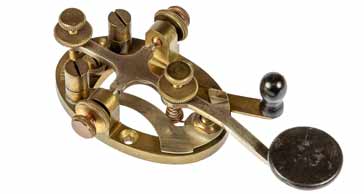
The issue was that the brass levers were coming loose on their steel axes when subjected to the continual use and sometimes quite heavy handed action of some operators. Often the keys were subjected to lateral forces exerted by the telegraphists as it was difficult to keep to a perfect up and down movement when sending for extended periods.
The wear not only meant that the action of the key was impaired, but it also started to stick when the lever was released. One response to this was to create heavier brass keys that would stand the wear better, but these were often felt to be heavy and less responsive when compared to the lighter telegraph keys often used.
During the 1870s and 1880s, many key manufacturers experimented with various methods of overcoming the issue.
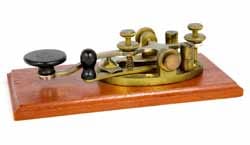
This one was most likely manufactured around 1920 but it follows the basic design introduced by James Bunnell in 1881.
It was actually J H Bunnell who devised the solution that was to become the definitive solution. He used a steel lever which provided a much harder surface for the bearing and this considerably reduced the issue of wear and solved the problem.
Bunnell patented his idea for a steel lever telegraph key on 15 February 1881. The design became very popular and int he subsequent years many other manufacturers followed his lead, especially after the patent ran out.
The design was so popular that it has remained in use to this day.
Steel lever telegraph key construction
In terms of its construction, this style of Morse key consists of an oval metallic base ring which has two bearings on each of the flatter sides of the oval. The steel lever is held between the two bearings. and these have adjustments to take up any wear. There are also adjustments at end of the lever away from the operator to give the required gap. And there's another adjustment for the spring tension.
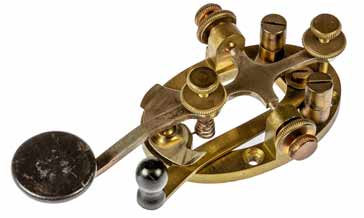
Its construction means that the key is relatively light and this was ideal for American telegraph operators as they were often itinerant and took their own telegraph keys with them.
Steel lever key in use
The steel lever key was easy to use and had a good action. Being light, it provided a very responsive feel when set up properly.
The key should be set up to suit the style of operation - gap and tension to suit the person using it. Every person will have their own preferences. However it is wise not to make the gap too small otherwise there may be a tendency to make it too sensitive and spurious dots or dashes may be created.
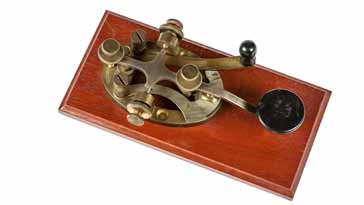
The basic telegraph key comes as the metal section only, but needed attaching to a table top work surface directly, or placed on a small wooden mount like the one shown here.
Although attaching the key to a separate wooden block has many advantages in terms of making it portable and also not damaging work surfaces, the key can have more of a tendency to move, although with a little care this should not be an issue.
Steel lever key illustrated
The Morse telegraph key used in the illustrations has the words Telegraph Key and AT&T Co in the top end of the main oval base ring for the key.
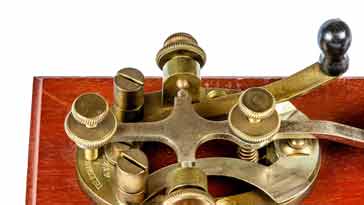
Some other examples of this type of key are known to have the words Western Electric on some piece parts and therefore were probably made by that company for AT & T. It is quite possible this one could also have been made by them.
The steel lever Morse telegraph key has been a very popular design down the years. Although it was first introduced by J H Bunnell and versions are still made by them even today, the basic design has been adopted by very many companies over the years, especially after the design fell out of patent. Many versions originated from japan, China and many other countries in the 1960s and later.
Overall the key has been very successful and has been a delight to use - in fact it is still used by many radio amateurs and telegraph enthusiasts to this day.
 Written by Ian Poole .
Written by Ian Poole .
Experienced electronics engineer and author.
More History:
Radio history timeline
History of the radio
Ham radio history
Coherer
Crystal radio
Magnetic detector
Spark transmitter
Morse telegraph
Valve / tube history
PN junction diode invention
Transistor
Integrated circuit
Quartz crystals
Classic radios
Mobile telecoms history
Vintage mobile phones
Return to History menu . . .




